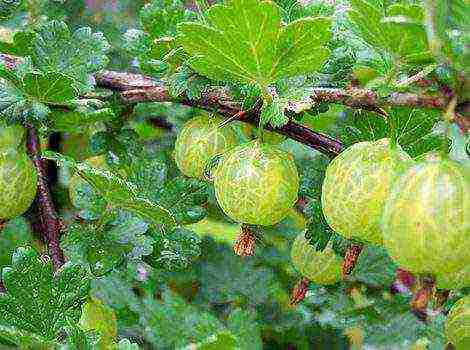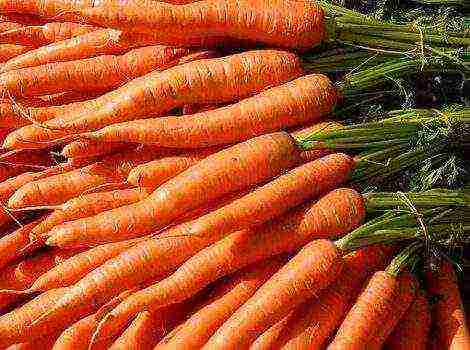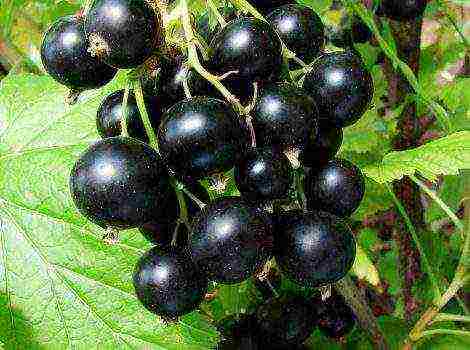Content
- 1 Botanical description
- 2 Growing conditions for maned barley
- 3 Growing maned barley from seeds
- 4 How to care for maned barley
- 5 Diseases and pests
- 6 Useful properties of the plant
- 7 Maned barley in landscape design
- 8 Bouquets and compositions with maned barley
- 9 Characteristic
- 10 Landing
- 11 Watering
- 12 Fertilizing the soil
- 13 Reproduction
- 14 Description
- 15 Growing places
- 16 Landscape design
- 17 What to combine with?
- 18 Seat selection
- 19 Landing
- 20 Care
Barley is a well-known cereal crop, but many do not even realize that it can be used for decorative purposes. It will become an interesting decoration of the garden, bring airiness, lightness, and create an atmosphere of mystery. In reproduction, maned barley is simple, caring for it will not be difficult - the task is within the power of even beginner gardeners.
Botanical description
Maned barley, in Latin Hordeum jubatum, is a perennial plant of the Cereal family. In its natural environment, it stretches across the steppes of North America. The height of the bush varies from 15 cm to half a meter (depending on the fertility of the soil). Herbaceous stems are thin, flexible, and have a greenish tint. The deciduous mass is dense: the leaves are oblong, belt-like, with pointed tops, the color is rich green.
When the flowering of maned barley comes
Fancy silky inflorescences-spikelets appear in July. Their length is 5-6 cm. They are decorated with long hairs with a pinkish or purple tint, which, when the wind blows, develop like a mane. The splendor lasts until the end of summer, with grains beginning to ripen in September. If the inflorescences are cut off in time, re-flowering is possible.
Maned barley spikes from the first year of life. Over time, the plantings grow and become even more beautiful. But there is no danger of aggressive spreading over the site - the culture is not a malicious weed.
The sprouts appear in early spring. You can easily distinguish them by their greenish-bluish tint. The root system is shallow: the plant is easy to pull out, so be careful when piercing.
Does it hibernate or not?
Barley is definitely an annual plant: the crop dries up completely when the seeds ripen. It can multiply by self-sowing, the main thing is that the sprouts do not freeze out in early spring, when the snow melts, and severe frosts are possible.
You can surprise yourself and your friends with new plants in a flower bed every year, do not be afraid to experiment. Maned barley looks unusual, and planting and caring for it is not easy.
Growing conditions for maned barley
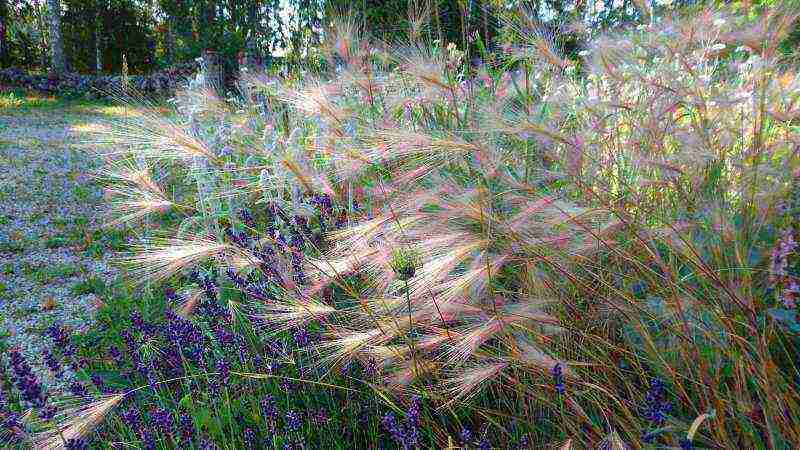
Maned barley planting and care photos in the garden
- The culture is drought tolerant - can be grown in open sunny areas.
- In light shading, it will retain its decorative effect longer (under the influence of the sun, ears ripen faster).
- Does not tolerate flooding and spring floods. Grow in elevated areas to allow meltwater and sediment to drain from the roots.
- Bushes can lie down during prolonged rains. Low plants can protect against this. Plant nearby, for example, sedum, lobelia, heuchera.
- Grows normally in poor soil (sandy is suitable). The nutritious soil promotes more vigorous growth.
Growing maned barley from seeds

Maned barley seeds photo
Reproduction is exclusively seed. The seed can be purchased at your specialist shop. For good seedling, select clean, large seeds for sowing. They must be stratified before planting.To do this, put a thin layer of peat on the bottom of a small tray, spread the seeds over the surface, cover with cling film on top, make several holes, store in the vegetable section of the refrigerator for 1-2 months.
When and how to sow in the ground
It can be sown in open ground in the spring (around April) or before winter (in this case, the seeds will undergo a natural process of stratification).
The site should be pre-prepared, do it a couple of weeks before sowing or planting. Dig a shovel bayonet floor to a depth, apply mineral fertilizers and compost, remove weeds.
You can scatter seeds over the surface of the ground and close up with a rake, or make shallow rows at a distance of 10-15 cm, and rarely sow seeds. When shoots appear, they are thinned out to a distance of 5-6 cm between plants.
Care must be taken to ensure that the weeds do not drown out the tender shoots of maned barley. Later, when he gains strength, he will be able to independently reclaim the territory from small shoots of weeds.
How to grow seedlings

Maned barley growing from seeds for seedlings photo
If you grow seedlings, spikelet flowering will come much earlier. When to sow maned barley for seedlings? Start sowing in early to mid-March, and by mid-May, the seedlings will be ready for transplanting into open ground.
- Fill the seedling boxes with soil mixture (3 parts garden soil and 1 part sand), spread the seeds over the surface of the soil, lightly press into the soil, spray with a fine spray, press on top with a wooden board.
- For successful germination, provide moderate light, air temperature between 12-16 ° C, water as the topsoil dries.
- At the stage of emergence of 4 strong leaves (about 3 weeks of growth), plant in separate containers with a diameter of about 6 cm (peat pots or plastic cups are ideal for this).
- Grow on a warm windowsill. At the beginning of May, start hardening the seedlings: first, take them out into fresh air for a couple of hours, gradually increasing the time to a day.
- Transplant outdoors in mid-May. Transfer together with a lump of earth, water, lightly press down the soil around the seedling with your palms.
The plant tolerates the transshipment procedure well. To keep the bushes fluffy, place 2-4 seedlings in one hole.
How to care for maned barley

Maned barley description and photo
- Care consists in moderate watering, periodic loosening of the soil, if desired, add top dressing.
- Water during prolonged dry periods.
- Weeds can drown out young shoots - be sure to get rid of them.
- Also loosen the soil periodically to provide oxygen to the roots. Proceed with caution as the root system lies close to the surface of the soil.
- When applying dressings, it is worth focusing on potassium and phosphorus, the proportion of nitrogen should be minimal.
Diseases and pests
Waterlogging of the soil can lead to the development of diseases - mold and gray rot. Be sure to remove the affected areas. Fungicide treatment will be required.
Useful properties of the plant
Grains can be processed into healthy and tasty cereals. They are also used to make beer (this will require special equipment). The broth is used to relieve spastic pain.
Maned barley in landscape design
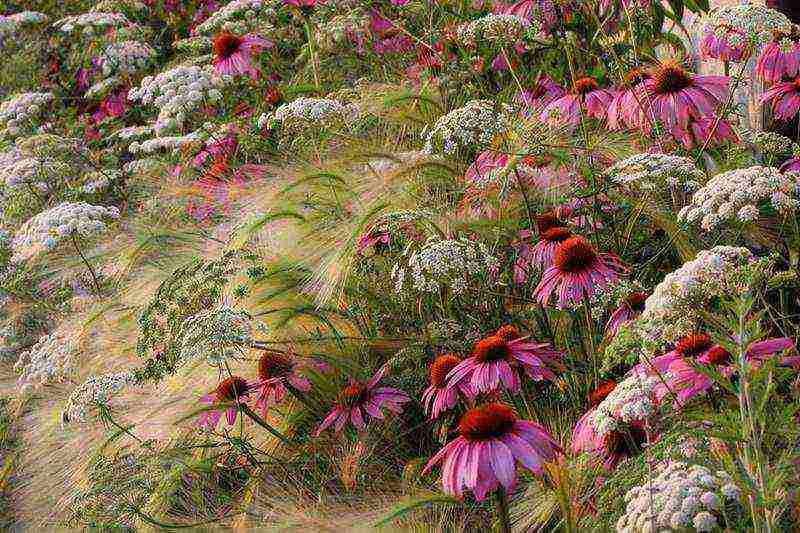
Maned barley in landscape design photo with flowers
It is multifaceted in use: it will fit into almost any composition, it looks self-sufficient in a solo planting, it is combined with other decorative grasses, evergreens and flowering plants.
Beautiful combinations with echinacea, garden daisies, decorative yarrow, phlox, coleus, brachicoma, lavater, sedum, allium, wildflowers.
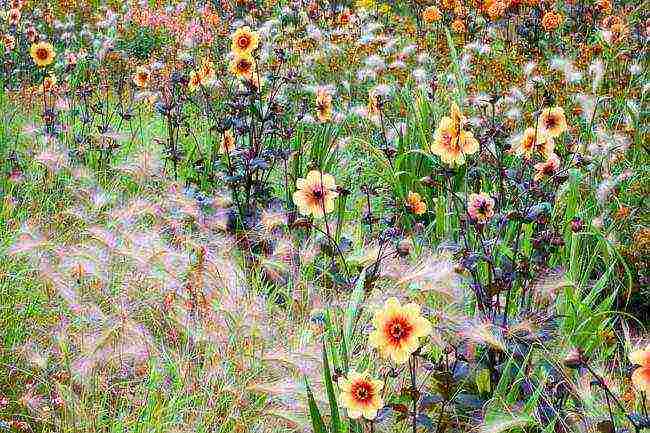
With what flowers to plant maned barley photo
It will give lightness and liveliness to the rocky areas of the garden, it is appropriate in rockeries, mixborders, on alpine slides. Can be used to fill voids after faded primroses. Decorate the lawn with its presence.

Maned barley, allium and sedum photo
Waves of airy spikelets are in harmony with such "brothers": haretail, openwork bent, pennisetum, rod-shaped millet.
In a composition with rudbeckia, calendula, marigolds of yellow-orange shades, it will give the flower bed a silvery shine. To create a calm, cool tone, combine with bicolor rosewort, sage, lavender.
Bouquets and compositions with maned barley

Maned barley in a bouquet photo
Spikelets of maned barley will fit into vivid natural-style bouquets (combine with wildflowers).
To prepare ears for creating dry bouquets and compositions, they should be cut in the first phase of earing. Tie in bunches, hang down with florets and dry in a well-ventilated area.
In winter bouquets, maned barley goes well with flowering and fruiting plants. It should be noted: flax, nigella, lunaria, stachis, wormwood, hedgehog, hogweed, physalis, echinacea. Combine with thorny plants: tease, rose hips, muzzle; cereals: corn, miscanthus, anthoxaum; it is in perfect harmony with inflorescences of heather, gypsophila, gomphrene, celosia, helipterum, xerantemum, edelweiss.
Do not be lazy to harvest dried flowers annually, as the created compositions quickly accumulate dust and can harm your health.
Barley is known to everyone as a cereal crop. Some do not even imagine that with its help you can decorate your garden at their summer cottage. Maned barley is perfect for this. He will bring lightness, airiness and mystery to your flower bed. Consider how to properly grow and care for it.
Characteristic
Maned barley is a perennial plant native to North America. It has found application on flower beds because of its bizarre and silky spikelets, the length of which reaches 5-6 cm. Ornamental barley prefers shade, since in the sun its ears ripen quickly and scatter their seeds throughout the site. Such a plant is not only used to decorate flower beds, flower beds and lawns, but it is also considered a great decoration for summer bouquets and dried flowers.
Maned barley tolerates any temperature changes well. It is considered frost-resistant. The only thing that the plant doesn't like is flooding. Accordingly, it needs to be planted in higher elevations so that melt water and rains flow down from the roots.
The plant begins to spike in the first year of life. Every year the barley will become bigger and more beautiful. If you decide to refresh your flower bed, then you should choose maned barley. Planting and leaving is easy. But let's take everything in order.
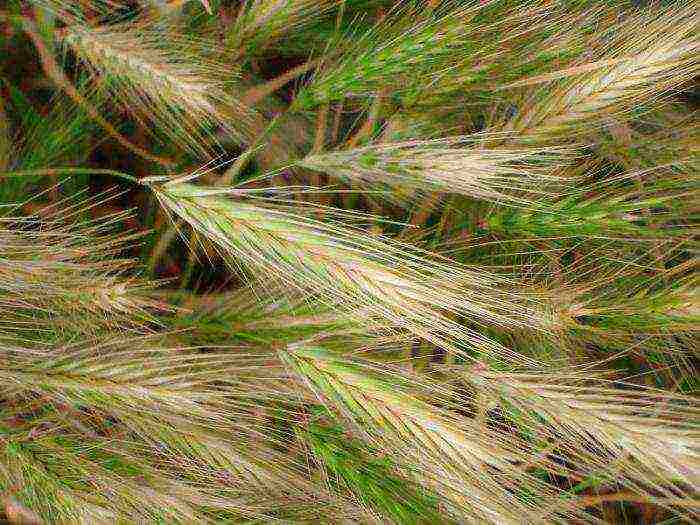
Landing
First of all, the seed is prepared. To begin with, sorting such an ornamental culture as maned barley is performed. The seeds must be clean and large. Only in this case, good shoots can be expected. There is no need to grow seedlings, you can immediately transfer the seeds to open ground. The most favorable time for disembarkation is mid-May. Prepare the soil before sowing. To do this, you need to do the following:
- dig up the ground;
- to clear it of weeds;
- add compost and mineral fertilizers to the soil.
If a transplant is required, then the barley will easily outlast it. The main thing is to choose the right place, and it will delight you.
Few people know, but the plant has some beneficial properties. Let's consider them:
- Barley can be processed to produce tasty and healthy grits.
- This plant is used to make beer. True, for this you need the necessary equipment.
- You can make interesting compositions for home decoration from dried barley flowers.
- If you prepare a medicinal decoction, then it will help relieve spastic pain.
If you appreciate all these qualities, then feel free to choose maned barley. Growing a plant is a simple process, and you will get great pleasure from it.
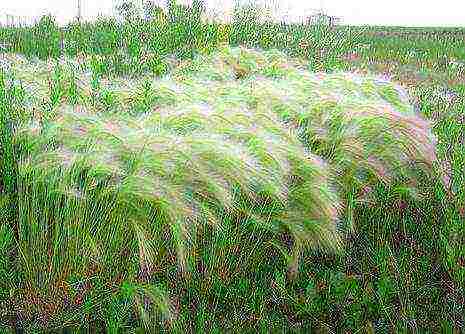
Watering
Moisturizing the soil is the main care for the plant. For watering to be useful, it is worth knowing some features:
- severe drought of the soil should not be allowed;
- you must be careful not to flood the plant. Because of this, the root system begins to rot.

Fertilizing the soil
Maned barley is one of those plants that love various feeding. If you are going to get a good harvest, then you need to apply fertilizer to the ground. There are several secrets:
- preparations should be with a high content of potassium and phosphorus;
- you need to fertilize the soil no more than once during the entire season;
- also, before each top dressing, be sure to weed and harrow the soil.
Reproduction
Maned barley is able to do this only by seeds. They can be purchased at specialized stores.

The plant is not an evil weed, so there is no need to fear that it will occupy the entire territory. In early spring, it is easy to distinguish it from other representatives of the flora by its green-bluish tint. Be careful when weeding. Barley can be easily pulled out as it has a shallow root system. If you do not miss the time and remove the inflorescences, then the barley will definitely bloom again. If you live in the northern regions of the country, then be prepared to sow the plant every year. It does not tolerate severe frosts, but in all other respects it is quite unpretentious.
Today we have told you all the secrets of such an interesting plant as maned barley. Planting and caring for this cereal is simple, even novice gardeners can handle them. Barley has not only decorative properties, but also useful qualities. Do not be afraid, experiment and grow amazing plants on your site that will delight the eye.
Very often, steppe and field plants are used to plant greenery in any areas, to decorate a garden, flower bed, lawn. The presence of such cultures adds flavor to the exterior. Maned barley is one of the most popular plants used for this purpose. Read about it in the article.
Description
This representative of the flora belongs to the group of cereals. By nature, maned barley is a wild steppe plant. Nevertheless, it has now become widespread in landscape design. This was facilitated by its unusual and attractive appearance.
The plant covers the flower beds with a dense grass carpet, which consists of silky spikelets and narrow leaves. Their width is no more than 3 millimeters. Actually, ears are the most attractive part of barley. They are many long inflorescences. They have bristles, the length of which reaches eight centimeters. They are collected in such a way that they resemble a fan.
Barley is a perennial plant, but it is used as an annual in garden design. It blooms magnificently in summer. The stalks swaying in the wind attract the eye. They resemble small ripples of the water surface. It looks very impressive. At first, they are painted in a green tint with a slight silver tinge, but after a while they become much lighter and acquire a straw color. At the base, the spikelets are covered with small reddish scales.
Growing places
Maned barley is widespread in the steppes of Eastern Siberia and the Far East. In addition, it is native to North America. It is used almost everywhere as a decorative element in bouquets.
Landscape design
Maned barley, the photo of which is presented in the article, is very often grown as one of the elements in a flower bed or in a flower garden.It looks most beneficial and appropriate in rocky gardens, rock gardens and lawns, but in this case it must be combined with other plants. You can use this variety of barley to fill the voids between crops that bloom quickly in spring. This plant can be included in the composition of dried flowers or decorative bouquets.
Barley is an unpretentious crop, resistant to temperature extremes and unfavorable environmental conditions. Since barley has a high cold resistance, this plant can be planted in areas where heat-loving flora does not take root. However, you should choose a sunny area and pre-moisten the soil. It's important not to overdo it. Excessive moisture will not benefit the plant.
What to combine with?
Maned barley is a crop that looks good next to other plants. What can be planted in combination with barley?
- Decorative cereals. Rod-shaped millet will look especially harmonious.
- Light-loving annuals, such as openwork bent grass, pennisetum and ovate haretail, go well with barley.
- Perennials with light silvery leaves are best suited for discreet compositions. Such plants include lavender, bicolor rosemary and sage.
- Vibrant crops such as marigolds and dwarf calendula pair very well with barley in picturesque summer beds.
Seat selection
Barley is planted in April, and in July it is already heading. If you plant at the end of August, then the flowering of the culture will be in June next year.
There are several rules to follow when choosing where to grow barley:
- The plant prefers well-lit areas, although it can bloom in the shade.
- Excess moisture will kill the barley. But the plant tolerates drought painlessly.
- The soil can be anything. The only caveat is not to plant the barley in heavy soil, which accumulates water and almost does not allow oxygen to pass through.
- As for acidity, the soil should be alkaline or slightly acidic.
- It is advisable to fertilize the soil with minerals and organics so that the barley is lush.
- Humus should be used as a top dressing.
Landing
How to grow maned barley? Planting a culture includes several stages. The first is seed preparation. First you need to stratify the grains. To do this, sprinkle the bottom of a small container with peat, distribute the seeds and cover them with another layer. Thus, you need to fill the entire container. Then you need to wrap all this with polyethylene, make several holes at the top for oxygen supply and put the container on the bottom shelf of the refrigerator.
Crop seeds should be placed in wide, shallow boxes. Place them in a cool place, which is illuminated by indirect sunlight. In no case should waterlogging of the soil in which maned barley grows be allowed. Planting and grooming are two interrelated procedures that, when done correctly, will allow a culture to grow healthy and robust.
Care
This culture is unpretentious, it grows very quickly. So that it does not fill up all the free space, it is necessary to thin out the maned barley. Plant care should be comprehensive. This means that it is necessary to water it in moderation, feed it on time and cut off the inflorescences before the seeds ripen on them. This is necessary so that the plant does not grow too much. You can achieve a beautiful wide row of barley by planting two or three plants in one hole.

Lush mixborders create a romantic, country-house-style atmosphere. But flowering plants will be able to truly reveal their unusual beauty only in combination with other ornamental plants.
One of such irreplaceable, in my opinion, partners is the maned barley of the cereal family.
The plant up to 50 cm high (on sandy soil below) is a dense turf with bright emerald linear graceful leaves. In July, barley "throws out" a lush cap of openwork spikelets with a delicate pink mane of the finest ostinks, which at the slightest breath of wind turns into an undulating sea.
Barley is especially beautiful on rocky areas, and in group plantings it creates an airy effect. This plant does not require care, it develops well on any soils, excluding waterlogged ones. Prefers sun or partial shade.
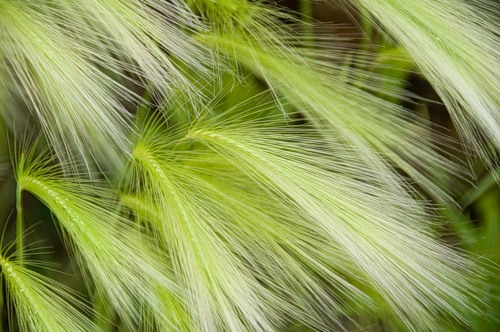
Barley is completely unpretentious, easily reproduces by dividing turf and self-sowing. In the spring, it is enough to notice (not weed out) it in any corner of the garden and move it to the place you need. And you can find it everywhere, even on the path among the rubble or between the tiles. You just need to gently pull on the thin bluish-green leaves, and a plant with a good root system will be in your hands. It will not even notice the transplant. It is easy to get a plant from seeds. You can sow seeds in the spring directly into open ground.

The plant is used as a dried flower for flower arrangements. Maned barley is the highlight that your garden lacks.
